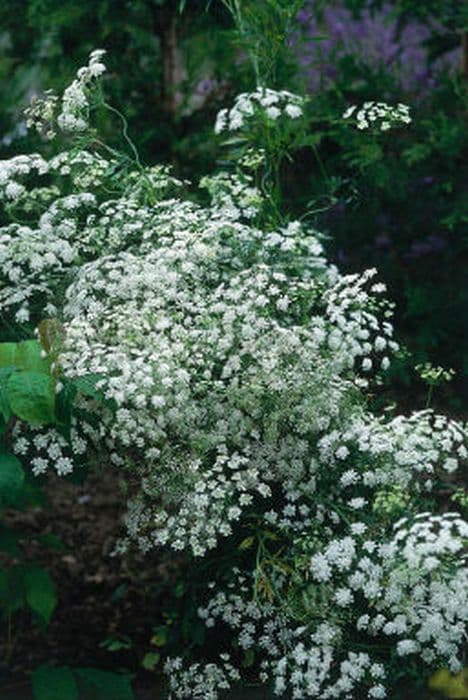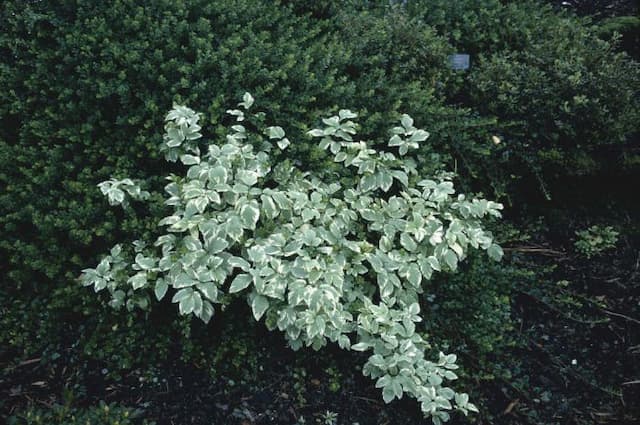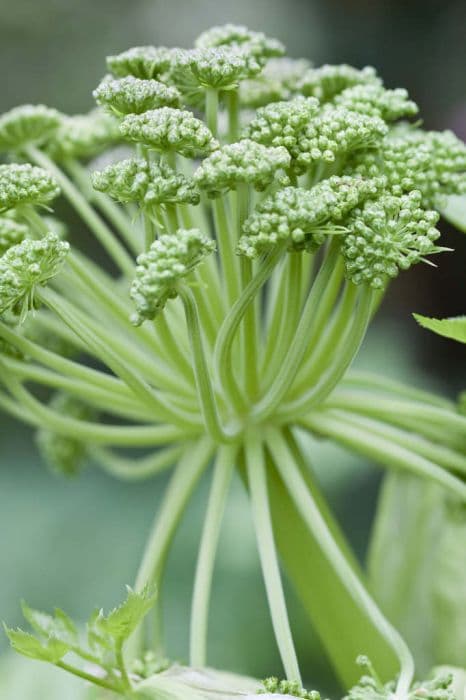Bishop's weed Ammi majus

ABOUT
Ammi majus, commonly known as Bishop's flower or Queen Anne's lace, is a striking plant notable for its delicate, lacy white flowers. Each flower is arranged in a large, flat-topped cluster that looks like an intricate lacework or a fine doily, hence the name. The individual flowers are small but numerous, and together they form a dense umbel that is quite attractive to butterflies and other pollinators. The foliage of Bishop's flower resembles that of a fern or carrot, with feathery, green leaves that are finely divided and soft to the touch. The overall shape of the plant is airy and light, giving it a buoyant, ethereal appearance in the garden. The stems are slender and branched, tending to be erect and giving the plant a bushy, spreading look. The contrast between the dark green foliage and the bright white flowers creates a striking visual effect, making Bishop's flower a popular choice for cut flower arrangements and as a companion plant in ornamental gardens. The delicate nature of its flowers juxtaposed with the more substantial foliage adds a touch of elegance to any planting scheme. The flower clusters make a strong visual impact when the plant is in full bloom, with the pure white of the flowers standing out against the green backdrop of summer foliage in the garden.
About this plant
 Names
NamesFamily
Apiaceae.
Synonyms
Bishop's Weed, False Bishop's Weed, Bullwort, Greater Ammi, Lady's Lace, Queen Anne's Lace, Laceflower.
Common names
Ammi majus L., Carum ammi, Daucus capillaceus, Selinum ammi.
 Toxicity
ToxicityTo humans
Bishop's weed, also known as Ammi majus, can be toxic to humans. The plant contains furanocoumarins, which can cause phytophotodermatitis, a skin reaction that occurs upon contact with the plant sap followed by exposure to sunlight. If ingested, Bishop's weed may lead to an increase in skin sensitivity to UV radiation, possibly causing rashes, blistering, or burns on skin exposed to sunlight. In severe cases, blistering and skin discoloration can last for several months. Internal consumption could potentially cause nausea, vomiting, or diarrhea.
To pets
Bishop's weed, also known as Ammi majus, may have toxic effects on pets if ingested. The furanocoumarins in Bishop's weed can lead to phytophotodermatitis in pets, similar to humans, causing skin irritation and increased sensitivity to sunlight. For animals that ingest parts of the plant, symptoms could include gastrointestinal disturbance, such as nausea, vomiting, and/or diarrhea. Avoid allowing pets to ingest this plant, and use caution when they are around it, to prevent potential skin and internal toxicity.
 Characteristics
CharacteristicsLife cycle
Biennials
Foliage type
Deciduous
Color of leaves
Green
Flower color
White
Height
2-3 feet (0.6-0.9 meters)
Spread
1 foot (0.3 meters)
Plant type
Herb
Hardiness zones
7
Native area
Mediterranean
Benefits
 General Benefits
General Benefits- Attracts Pollinators: Ammi majus is known to attract beneficial insects like bees and butterflies, which are essential for pollination.
- Garden Aesthetic: With its delicate white blooms, Bishop's flower adds an ethereal and elegant touch to gardens and landscapes.
- Companion Planting: It can be used in companion planting to enhance the growth of other plants and deter pests.
- Cut Flowers: The flowers of Bishop's weed are long-lasting when cut, making them a popular choice for floral arrangements and bouquets.
- Erosion Control: The plant's root system can help stabilize soil and control erosion in certain environments.
- Wildlife Habitat: By providing nectar, it creates a habitat for various species of wildlife, contributing to ecosystem diversity.
- Drought Resistance: Ammi majus is relatively drought-tolerant once established, making it suitable for xeriscaping and arid climates.
- Easy to Grow: It is generally easy to cultivate and can thrive in a wide range of soil conditions.
 Medical Properties
Medical Properties- Photodynamic therapy: Ammi majus contains compounds that can be used in photodynamic therapy, a treatment that involves light-sensitive medication and light to destroy cancer cells.
- Vitiligo treatment: The plant has been historically used to treat vitiligo due to the presence of psoralen which can stimulate tanning when applied topically and exposed to sunlight.
 Air-purifying Qualities
Air-purifying QualitiesThis plant is not specifically known for air purifying qualities.
 Other Uses
Other Uses- Insect repellent: Ammi majus has been used in gardens to help deter insects due to its strong smell.
- Photography: The delicate, lacy flowers of Bishop's weed make it a popular choice for photographers and nature enthusiasts who want to capture its intricate patterns.
- Dye production: The plant has been traditionally used to obtain a yellow dye, which was utilized in textile coloring processes.
- Flower arrangements: Bishop's weed is commonly used in floral arrangements and bouquets for its ornamental value and longevity in cut flower form.
- Ritual significance: In some cultures, Ammi majus has been used in various rituals and ceremonies due to its white, umbel-shaped flowers symbolizing purity.
- Horticultural research: It is sometimes used in genetic studies due to its simple flower structure, which is ideal for studying plant development.
- Education: Bishop's weed may be included in educational programs for botany or horticulture students to learn about umbelliferous plants and their characteristics.
- Garden design: Its height and structure are perfect for adding depth and texture to flower beds and borders within garden designs.
- Biological pest control: The plant is sometimes integrated into agricultural systems to attract beneficial insects that prey on pests.
- Companion planting: Ammi majus is occasionally planted alongside crops to naturally deter pests or attract pollinators, aiding in the overall health of the garden ecosystem.
Interesting Facts
 Feng Shui
Feng ShuiThe plant Bishop's flower is not used in Feng Shui practice.
 Zodiac Sign Compitability
Zodiac Sign CompitabilityThe plant Bishop's flower is not used in astrology practice.
 Plant Symbolism
Plant Symbolism- Innocence: The delicate white flowers of Bishop's flower (the most common name for Ammi majus) resemble purity and are often connected to innocence, making them a popular choice in bridal bouquets and christening ceremonies.
- Connection with Nature: The natural, wildflower-like appearance of Bishop's flower suggests a deep connection with the natural world and signifies someone who is in harmony with their surroundings.
- Simplicity: Bishop's flower is not overly showy or ornate, which symbolizes the beauty of simplicity and the appreciation of understated elegance.
- Support: Because of their sturdy stems and the way the small flowers support each other in the umbel, they can symbolize community and the idea of individuals coming together to provide mutual support.
 Water
WaterBishop's weed should be watered regularly to keep the soil consistently moist but not soggy. During the growing season, approximately once a week should suffice, but this frequency should be adjusted based on temperature, humidity, and soil moisture levels. A rough estimate would be about 1 inch of water per week, which equates to roughly 0.6 gallons for a 10 square foot area. During hot, dry periods, more frequent watering may be necessary. Always check the soil moisture at a depth of a couple of inches; if it feels dry, it's time to water.
 Light
LightBishop's weed thrives in full sunlight to partial shade. The ideal spot would receive at least 6 hours of direct sunlight each day, although it can tolerate some light afternoon shade, especially in hotter climates. Avoid deeply shaded areas, as insufficient light can lead to poor flowering and leggy growth.
 Temperature
TemperatureBishop's weed prefers temperate climates and performs best within a temperature range of 50°F to 75°F. It can survive minimal frost and colder temperatures down to about 20°F, but prolonged exposure to extreme cold or heat may harm the plant. Ideal growing conditions would include mild days and cooler nights within the preferred temperature range.
 Pruning
PruningPruning Bishop's weed mainly involves deadheading spent flowers to encourage further blooming. Trim the plant back after the first flush of flowers to promote a second bloom. General pruning is done in early spring or late fall. Pruning during the growing season helps maintain the plant’s shape and remove any damaged or diseased foliage.
 Cleaning
CleaningAs needed
 Soil
SoilBishop's flower (Ammi majus) thrives in well-draining, fertile loam with a slightly acidic to neutral pH between 6.0 and 7.0. A mix of two parts garden soil, one part compost, and one part sand or perlite is ideal to ensure adequate drainage and fertility.
 Repotting
RepottingBishop's flower, also known as Ammi majus, typically does not require frequent repotting as it is often grown as an annual. It should be sown directly into the garden or started in biodegradable pots that can be planted into the soil to avoid root disturbance.
 Humidity & Misting
Humidity & MistingBishop's flower (Ammi majus) is tolerant of a wide range of humidity levels and does not require high humidity. Average room humidity is generally sufficient for this plant.
 Suitable locations
Suitable locationsIndoor
Place Ammi majus in bright, indirect light and maintain room temperature.
Outdoor
Plant Bishop's flower in full sun to partial shade in fertile soil.
Hardiness zone
7-10 USDA.
 Life cycle
Life cycleAmmi majus, commonly known as Bishop's weed or false Queen Anne's lace, begins its life cycle with seed germination, typically taking place in early spring under suitable temperature and moisture conditions. The seedlings emerge and grow into rosettes of feathery, finely divided leaves, drawing nutrients from the soil to establish themselves. As the plant matures, it develops a sturdy flowering stem and produces large, compound umbels of tiny, white flowers throughout the summer months, attracting a host of pollinators. After pollination, the flowers develop into fruiting bodies, which release seeds when mature. These seeds then drop to the ground or are dispersed by wind, animals, or other means to new locations. The plant may complete its life cycle within a single year (annual) or over two years (biennial), dying after seed production, while the seeds remain dormant over winter and begin the cycle anew when conditions are favorable.
 Propogation
PropogationPropogation time
Spring-early summer
The most popular method of propagation for Bishop's Weed (Ammi majus) is by sowing seeds. The ideal time to sow Ammi majus seeds is in early spring, as soon as the soil can be worked, or in autumn where winters are mild. Seeds should be scattered sparsely onto prepared soil and lightly covered with about an eighth of an inch (approximately 3 millimeters) of soil. Keeping the soil moist is critical until germination, which typically occurs within 7 to 14 days. Seedlings may require thinning to about 9 to 12 inches (approximately 23 to 30 centimeters) apart to ensure they have enough room to grow. Bishop's Weed prefers a sunny location with well-drained soil for optimal growth and flowering.









